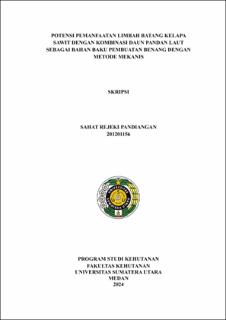| dc.contributor.advisor | Risnasari, Iwan | |
| dc.contributor.advisor | Nuryawan, Arif | |
| dc.contributor.author | Pandiangan, Sahat Rejeki | |
| dc.date.accessioned | 2024-12-06T07:01:53Z | |
| dc.date.available | 2024-12-06T07:01:53Z | |
| dc.date.issued | 2024 | |
| dc.identifier.uri | https://repositori.usu.ac.id/handle/123456789/99202 | |
| dc.description.abstract | Palm fibre and sea pandanus are natural fibres that have not been widely researched. Sea pandanus is blended with palm fibre to provide technical properties, flexibility to produce diversified products, and cost reduction. The way the fibre is collected is by following the granted patent number IDS000006288 by beating the boiled palm trunk to separate the vascular bundle from the parenchyma, while the sea pandanus uses an iron comb to obtain the fibre. The physical properties tested were moisture content and fibre specific gravity. While the mechanical properties are yarn tensile strength (maximum tension (stress), strain (strain) and Modulus young. The results of the physical properties test show the value of palm fibre moisture content with a value of 6.95% - 9.89%, in dry sea pandanus fibre is 5.82 - 11.11% and in fresh sea pandanus fibre ranges from 11.73 - 14.28% palm specific gravity value with a value of 0.82 - 0.90 l, in dry sea pandanus with a value of 0.94 - 1.03 and in fresh sea pandanus fibre ranges from 0.77 - 1.08. The highest average value of maximum stress was obtained in palm yarn with a combination of 5 dry sea pandanus fibres with a value of 8.60 N while the lowest value in palm yarn with a combination of 3 fresh sea pandanus fibres with a value of 3.80N. The strain test value obtained in the tests carried out has the same average value with a value of 0.3%, The highest average value of young modulus is obtained in palm yarn with a combination of dried sea pandanus 5 fibres with a value of 296.81 N while the lowest value in palm yarn with a combination of fresh sea pandanus 3 fibres with a value of 142.19 N. The results of testing on SPSS have been carried out where it is concluded that the number of fibres has no significant effect on yarn strength. | en_US |
| dc.language.iso | id | en_US |
| dc.publisher | Universitas Sumatera Utara | en_US |
| dc.subject | yarn | en_US |
| dc.subject | yarn tensile strength | en_US |
| dc.subject | sea pandanus | en_US |
| dc.subject | vascular bundle | en_US |
| dc.title | Potensi Pemanfaatan Limbah Batang Kelapa Sawit dengan Kombinasi Daun Pandan Laut sebagai Bahan Baku Pembuatan Benang dengan Metode Mekanis | en_US |
| dc.title.alternative | The Potency of Utilization of Oil Palm Trunk and Combination of Sea Pandan Leaves as Raw Material of Yarn Using Mechanical Method | en_US |
| dc.type | Thesis | en_US |
| dc.identifier.nim | NIM201201156 | |
| dc.identifier.nidn | NIDN0019087302 | |
| dc.identifier.nidn | NIDN0016047803 | |
| dc.identifier.kodeprodi | KODEPRODI54251#Kehutanan | |
| dc.description.pages | 57 Pages | en_US |
| dc.description.type | Skripsi Sarjana | en_US |
| dc.subject.sdgs | SDGs 7. Affordable And Clean Energy | en_US |


